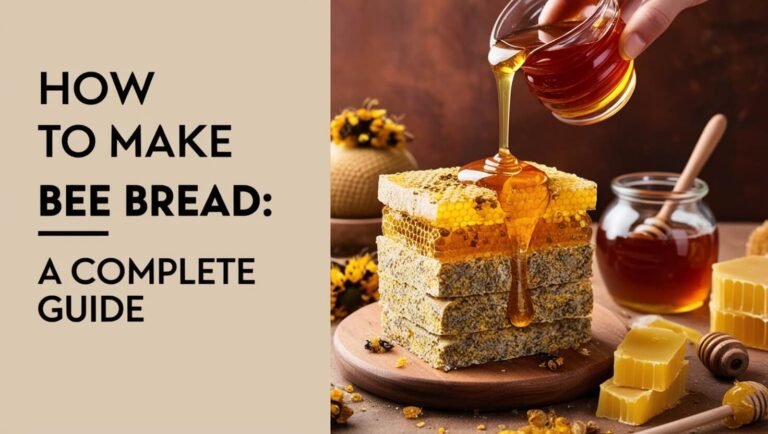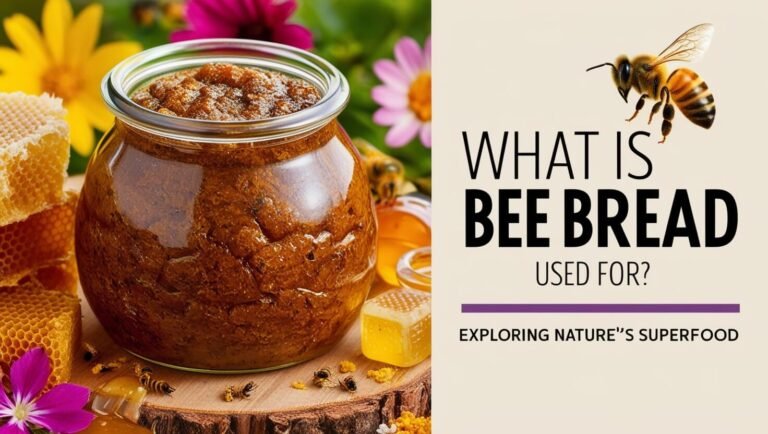What Is Bee Bread Made Of? A Comprehensive Guide to Nature’s Superfood

Bee bread is a nutrient-dense substance produced by bees, composed primarily of pollen, nectar, and bee saliva. This fermented food source is crucial for bee colony health and has gained attention for its potential human health benefits. In this comprehensive guide, we’ll explore the composition, production process, and significance of bee bread in both the hive ecosystem and human nutrition.
Introduction to Bee Bread
Defining Bee Bread: Nature’s Nutritional Powerhouse
Bee bread is a fermented mixture of plant pollen, nectar, and bee saliva that serves as the primary protein source for honey bees. This unique substance is packed with essential nutrients, including proteins, carbohydrates, lipids, vitamins, and minerals. Unlike raw pollen, bee bread undergoes a fermentation process that enhances its nutritional value and digestibility.
The Importance of Bee Bread in the Hive Ecosystem
In the complex world of bee colonies, bee bread plays a vital role:
- Nutrition: It serves as the primary food source for adult bees and developing larvae.
- Colony Growth: Adequate bee bread supplies are essential for healthy brood rearing and colony expansion.
- Longevity: The nutrient-rich composition of bee bread contributes to the overall health and longevity of worker bees.
The Composition of Bee Bread
Primary Ingredients in Bee Bread
Bee bread is composed of three main ingredients:
- Pollen: Collected by forager bees from various plant sources.
- Nectar: A sweet liquid produced by plants, collected by bees.
- Bee saliva: Contains enzymes that initiate the fermentation process.
Nutritional Profile of Bee Bread
Bee bread boasts an impressive nutritional profile:
- Proteins: 20-35% of dry weight
- Carbohydrates: 24-35% of dry weight
- Lipids: 1-5% of dry weight
- Vitamins: Including B-complex vitamins, vitamin C, and vitamin E
- Minerals: Such as potassium, calcium, magnesium, and zinc
- Enzymes: Including amylase, catalase, and phosphatase
- Antioxidants: Various flavonoids and phenolic compounds
Comparing Bee Bread to Other Bee Products
While bee bread shares some similarities with other bee products, it has unique characteristics:
- Compared to raw pollen: Bee bread has enhanced bioavailability of nutrients due to fermentation.
- Versus honey: Bee bread has a higher protein content and a more diverse range of nutrients.
- In relation to royal jelly: While both are nutrient-dense, bee bread is more widely consumed within the hive.
The Process of Making Bee Bread
From Flower to Hive: The Journey of Pollen
The creation of bee bread begins with pollen collection:
- Forager bees visit flowers to collect pollen grains.
- Pollen is mixed with nectar and bee saliva to form pollen pellets.
- These pellets are transported back to the hive in specialized structures called pollen baskets or corbiculae.
The Role of Bees in Bee Bread Production
Once in the hive, worker bees take over:
- Pollen pellets are removed from the returning foragers.
- The pellets are packed into honeycomb cells.
- A thin layer of honey is added to create an anaerobic environment.
- Enzymes from bee saliva initiate the fermentation process.
Fermentation: The Key to Bee Bread’s Unique Properties
The fermentation process is crucial in transforming pollen into bee bread:
- Lactic acid bacteria present in the bee’s digestive system play a key role.
- Fermentation breaks down complex compounds, making nutrients more accessible.
- The process also preserves the bee bread, allowing for long-term storage in the hive.
- Fermentation typically takes 7-14 days to complete.
Breaking Down the Components of Bee Bread
Proteins and Amino Acids in Bee Bread
Proteins are essential for bee development and overall health:
- Bee bread contains all essential amino acids.
- The protein content can vary from 20-35% depending on the pollen source.
- Common amino acids include proline, lysine, and leucine.
Carbohydrates: The Energy Source in Bee Bread
Carbohydrates provide energy for the bees:
- Simple sugars like fructose and glucose are present.
- Complex carbohydrates offer sustained energy release.
- Fiber content aids in digestion and gut health.
Fats and Fatty Acids: Essential Nutrients in Bee Bread
While lower in quantity, fats play crucial roles:
- Essential fatty acids support bee development and immune function.
- Common fatty acids include linoleic acid and α-linolenic acid.
- Lipids contribute to the overall caloric content of bee bread.
Vitamins and Minerals: Micronutrients in Bee Bread
A wide array of vitamins and minerals are found in bee bread:
- B-complex vitamins: Including B1, B2, B3, B5, B6, and B9
- Vitamin C: An important antioxidant
- Vitamin E: Supports cellular health
- Minerals: Such as potassium, calcium, magnesium, zinc, and iron
Bioactive Compounds in Bee Bread
Beyond basic nutrients, bee bread contains various bioactive substances:
- Flavonoids: Plant-based antioxidants with potential health benefits
- Phenolic compounds: Another class of antioxidants
- Carotenoids: Precursors to vitamin A and antioxidants
- Enzymes: Including amylase, catalase, and phosphatase
Factors Influencing Bee Bread Composition
Impact of Floral Sources on Bee Bread Composition
The composition of bee bread can vary significantly depending on the pollen sources:
- Different plant species provide varying nutrient profiles.
- Some plants offer pollen rich in specific amino acids or minerals.
- The diversity of floral sources contributes to the overall nutritional balance.
Geographical and Seasonal Variations in Bee Bread
Location and time of year play a role in bee bread composition:
- Regional plant diversity affects available pollen sources.
- Seasonal changes in flora impact the types of pollen collected.
- Climate conditions can influence the nutritional content of pollen.
The Influence of Bee Species on Bee Bread Production
Different bee species may produce slightly different bee bread:
- Variations in digestive enzymes can affect fermentation.
- Foraging preferences may differ among bee species.
- The size and structure of pollen baskets can impact collection efficiency.
The Benefits of Bee Bread for Bees
Bee Bread as a Complete Food Source for Bees
Bee bread serves as an all-in-one nutritional package:
- Provides proteins for growth and development
- Offers carbohydrates for energy
- Supplies essential fats, vitamins, and minerals
- Supports the nutritional needs of adult bees and larvae
The Role of Bee Bread in Bee Colony Health
A steady supply of high-quality bee bread is crucial for colony vitality:
- Supports immune function in bees
- Enables efficient brood rearing
- Contributes to the longevity of worker bees
- Helps maintain overall colony strength and resilience
Potential Health Benefits of Bee Bread for Humans
Nutritional Value of Bee Bread in Human Diet
While primarily a bee food, bee bread has gained attention as a potential superfood for humans:
- High-quality protein source
- Rich in antioxidants
- Provides a wide spectrum of vitamins and minerals
- Contains bioactive compounds with potential health benefits
Potential Therapeutic Properties of Bee Bread
Research suggests bee bread may offer various health benefits:
- Antioxidant properties: May help combat oxidative stress
- Immune system support: Could enhance immune function
- Antimicrobial effects: Some studies indicate antibacterial properties
- Potential anti-inflammatory action: May help reduce inflammation
It’s important to note that while promising, many of these benefits require further research to fully understand their implications for human health.
Harvesting and Consuming Bee Bread
Sustainable Harvesting Practices for Bee Bread
Ethical harvesting is crucial to maintain bee colony health:
- Only excess bee bread should be harvested
- Harvesting should be done during periods of abundant pollen flow
- Special tools and techniques help minimize hive disruption
- Beekeepers must ensure sufficient stores remain for the bees
Ways to Incorporate Bee Bread into Your Diet
For those interested in trying bee bread:
- Raw consumption: Can be eaten as is, though the taste is quite strong
- Mixed into smoothies or yogurt
- Added to granola or muesli
- Used as a topping for toast or crackers
- Incorporated into energy bars or bites
Always consult with a healthcare professional before adding new supplements to your diet, especially if you have allergies or other health concerns.
Conclusion: The Marvels of Bee Bread
Recap of Bee Bread’s Composition and Significance
Bee bread is a remarkable substance that showcases the incredible capabilities of honey bees:
- A nutrient-dense food created through the collaboration of bees and nature
- Essential for bee colony health and survival
- Composed of a complex mix of proteins, carbohydrates, fats, vitamins, and minerals
- Produced through a unique fermentation process that enhances its nutritional value
The Future of Bee Bread Research and Applications
As interest in bee bread grows, so does the potential for future developments:
- Ongoing research into its potential human health benefits
- Exploration of bee bread’s role in supporting bee conservation efforts
- Investigation of sustainable harvesting and production methods
- Potential applications in natural medicine and nutrition
In conclusion, bee bread represents a fascinating intersection of bee biology, plant ecology, and nutritional science. As we continue to unravel its secrets, this humble substance may offer valuable insights into both bee health and human nutrition. Whether you’re a beekeeper, a nutrition enthusiast, or simply curious about the natural world, bee bread serves as a testament to the intricate and often surprising ways in which nature provides nourishment for its diverse inhabitants.




